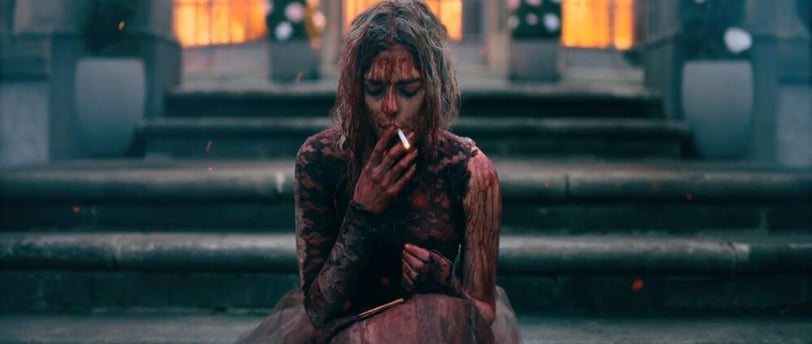From Prey to Predator: The Empowering Women of Modern Horror
Discover the rise of self-reliant heroines in horror films like Ready or Not, The Hunt, and The Menu. Learn how these empowered protagonists challenge the outdated damsel in distress trope.
HORROR TROPES
Amber Dean
3 min read


From Helpless to Heroic: The Rise of Self-Reliant Heroines in Horror
The damsel in distress has long been a cornerstone of storytelling, particularly in horror films and literature. For centuries, female characters were cast as passive victims, waiting for a male savior to rescue them. But today’s horror heroines are rewriting the script. In films like Ready or Not, The Hunt, and The Menu, women take center stage—not as helpless victims but as empowered survivors.
This evolution signals a critical cultural shift, moving away from outdated gender stereotypes and toward narratives that celebrate female agency, resilience, and complexity.
The Damsel in Distress: Why It's Time to Retire This Outdated Trope
Historically, the damsel in distress trope symbolized fragility and dependence. In Gothic literature of the 18th and 19th centuries, women were often depicted as beautiful but helpless figures, their salvation reliant on a male hero.
In horror films, this archetype reinforced traditional gender roles, reducing female characters to little more than plot devices. Men were protectors; women were victims. While this dynamic may have resonated with cultural norms of the past, it also perpetuated harmful stereotypes about femininity and female agency.
Over decades, these narratives shaped not only the genre but also societal expectations, portraying vulnerability as intrinsic to women’s identities. The result? A stagnant portrayal of women that failed to reflect their strength, intelligence, and complexity.
Self-Reliant Heroines in Horror: A New Era of Empowerment
Modern horror has taken a thrilling turn. Self-reliant heroines now dominate the genre, challenging the trope of the damsel in distress and reframing women as capable protagonists.
These characters don’t wait for rescue—they fight back. They are smart, resourceful, and brave, engaging with their fears and actively shaping their fates. This shift reflects a broader cultural appetite for stories that celebrate autonomy and defy outdated gender norms.
Case Studies: Empowered Women in Ready or Not, The Hunt, and The Menu
Grace in Ready or Not
Grace, a newlywed thrust into her in-laws’ deadly ritual, starts the film as a wide-eyed bride but transforms into a blood-soaked survivor. Her resilience and determination are central to her journey. By the end, Grace’s fight for survival is not just physical but symbolic—a rejection of the societal expectations imposed on her.
Crystal in The Hunt
Crystal is underestimated from the start, but her tactical brilliance and calm demeanor make her a formidable opponent. As she outwits her captors, she reclaims her narrative, turning the tables on those who sought to control her. Crystal embodies the self-reliant heroine, proving that strength lies in adaptability and intelligence.
Margot in The Menu
In a nightmarish setting of culinary chaos, Margot outsmarts her captors by leveraging her wit and emotional intelligence. Her refusal to conform to the game’s twisted rules highlights her agency, making her a standout example of modern horror’s shift toward empowered female protagonists.
How Films Like Ready or Not Redefine Women in Horror
The rise of self-reliant heroines like Grace, Crystal, and Margot reflects deeper societal changes. Viewers now demand characters who are multidimensional and relatable, not caricatures of vulnerability.
These heroines do more than survive—they challenge power dynamics, critique societal norms, and inspire audiences. They demonstrate that women in horror can be both vulnerable and strong, terrified yet courageous, flawed yet triumphant.
The Future of Female Representation in Horror Movies
As horror continues to evolve, so too will its heroines. The future promises even more nuanced and empowering portrayals of women, with stories that explore their complexities in innovative ways.
What’s Next?
Greater diversity in female protagonists, reflecting varied backgrounds and experiences.
Narratives that explore empowerment through themes like motherhood, friendship, or autonomy.
Bold challenges to genre conventions, pushing the boundaries of what horror can be.
The death of the damsel in distress trope is more than a storytelling shift—it’s a cultural milestone. By embracing self-reliant heroines, horror films are not only entertaining audiences but also redefining gender norms and expectations.
Why This Matters: Cultural Impact and Empowerment
The self-reliant heroine isn’t just a win for horror fans—it’s a win for cultural representation. These characters challenge outdated stereotypes, inspiring audiences to see women as agents of their own destinies.
By rejecting the damsel in distress archetype, filmmakers are creating a space where women’s strength, intelligence, and resilience can shine. This shift doesn’t just make for better stories—it makes for better representation.
Final Thoughts
The damsel in distress is dead, and horror is better for it. Films like Ready or Not, The Hunt, and The Menu show us what’s possible when female characters are written with depth, agency, and strength.
As the horror genre evolves, let’s continue to celebrate heroines who confront their fears and fight back—not just for survival, but for their rightful place at the center of the narrative.
